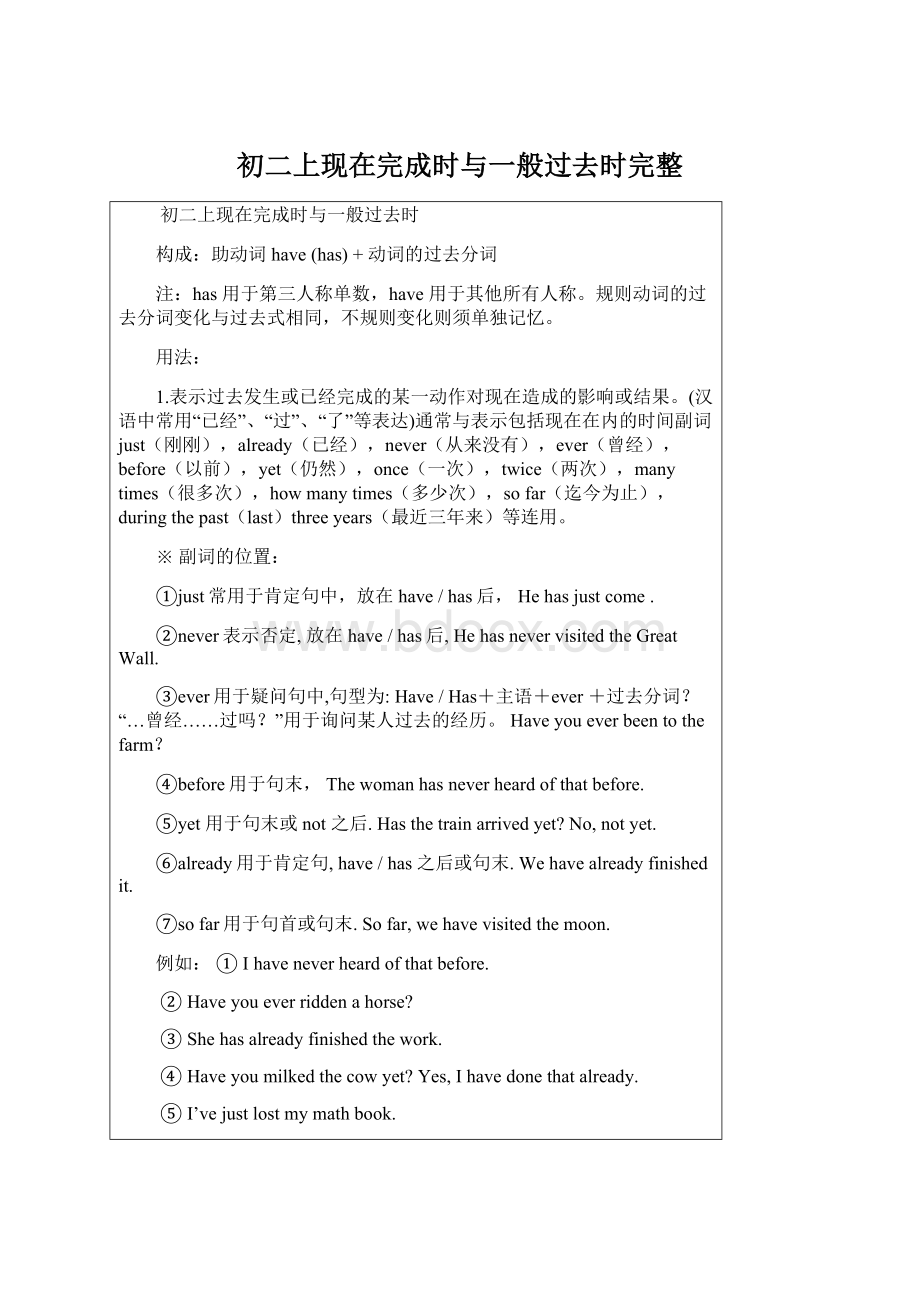初二上现在完成时与一般过去时完整Word格式文档下载.docx
《初二上现在完成时与一般过去时完整Word格式文档下载.docx》由会员分享,可在线阅读,更多相关《初二上现在完成时与一般过去时完整Word格式文档下载.docx(24页珍藏版)》请在冰豆网上搜索。

②Haveyoueverriddenahorse?
③Shehasalreadyfinishedthework.
④Haveyoumilkedthecowyet?
Yes,Ihavedonethatalready.
⑤I’vejustlostmymathbook.
2.现在完成时表示过去已经开始,持续到现在,也许还会持续下去的动作或状态。
可以和表示延续的时间状语连用。
如for、since等引导的时间状语。
(注意:
句中谓语动词要用延续性动词)
一段时间的表达方法有两种:
①
for+表示一段时间的词语IhavetaughtEnglishfor19years.
②
since+表示过去时间点的词语Hehasbeenatthisschoolsince1986.
③
since+表示过去的时间状语从句IhavelivedheresinceIwasborn.
④
since+一段时间+ago.Ihaveknownhimsince20yearsago.
注意:
for和since所引导的时间状语都表示一段时间.
Hehasbeenawaysincelastweek.
Hehasbeenawayforoneweek.对划线部分提问都用Howlong
下四大标志词可以表达这种含义:
*以already,just和yet为标志
already,just和yet表示到现在为止动作或状态已经、刚刚或还没有发生。
Hehasalreadygotherhelp. 他已得到她的帮助。
Hehasjustseenthefilm. 他刚刚看过这场电影。
Hehasn'
tcomebackyet. 他还没有回来。
*以ever和never为标志
ever和never表示到现在为止动作或状态曾经或从来没有发生过。
ThisisthebestfilmIhaveeverseen. 这是我曾经看过的最好的一部电影。
HehasneverbeentoBeijing. 他从没有到过北京。
*以动作发生的次数为标志
若某一动作到现在为止已经发生了若干次,则要使用现在完成时。
HesayshehasbeentotheUSAthreetimes.他说他已经去过美国三次了。
*以sofar为标志
sofar往往表示到目前为止动作或状态已经发生。
HehasgottoBeijingsofar. 到目前为止他已到了北京。
Shehaspassedtheexamsofar. 到目前为止她已经通过了考试。
五、使用时注意事项
1.“have/hasgot”形式上是一种完成时,但和have/has为同一意思“有”。
Haveyougotpen-friends?
Yes,Ihave.
你有笔友吗?
是的,我有。
Hashegotalotofworktodo?
No,hehasn’t.
他有许多工作要做吗?
不,他没有。
2.have/hasgoneto、have/hasbeento和have/hasbeenin的区别。
have/hasgoneto去了,在去某地的路上或在某地,人还未回来
have/hasbeento曾经去过,人已经回来了
have/hasbeenin已经在,常与一段时间连用
HehasbeentoShenyangbefore.他以前曾去过沈阳。
HehasbeeninShenyangfortenyears.他在沈阳10年了。
HashegonetoShenyang?
他去沈阳了吗?
3.have/hasbeento常和once,twice,never,ever连用;
have/hasgoneto则不可。
例如:
─HasTomeverbeentoParis?
汤姆去过巴黎吗?
─Yes,he’sbeenthereseveraltimes.是的,他去过好几次了。
─Wherehavetheygone?
他们去哪里了?
─They’vegonetoShenyang.他们去沈阳了。
扩展与总结:
since的四种用法
1)since+过去一个时间点 (如具体的年、月、日期、钟点、1980,lastmonth,halfpastsix)。
Ihavebeenheresince1989.
2)since+一段时间+ago
Ihavebeenheresincefivemonthsago.
3)since+从句
Greatchangeshavetakenplacesinceyouleft.
Considerabletimehaselapsedsincewehavebeenhere.
4)Itis+一段时间+since从句
ItistwoyearssinceIbecameapostgraduatestudent.
练习:
用since或for填空:
1.Ihavebeenatthisschool____________morethantwoyears.
2.Shehasworkedinthefactory___________tenyearsago.
3.Mr.Greenhaslivedinthecity____________hewasborn.
4.Hisfatherhasbeenapartymember___________twentyyears.
◆havebeen(to)和havegone(to)的区别:
have/hasbeen(to)表示“曾经到过某地”,说话时此人不在那里,已经回来。
侧重指经历。
have/hasgone(to)表示某人“已经去某地了”,说话时此人可能在路上或已到那里,反正不在这里。
试比较:
HehasbeentoBeijing.他曾去过北京。
(人已回来,可能在说话人的地方)
HehasgonetoBeijing.他已经去北京了。
(人去了,不在说话人的地方)。
用havegoneto,havebeento和havebeenin的适当形式填空:
1.Where_______________you________________,Lily?
2.Myfatherisn’there.He_________________Beijing.
3.Lucy__________________Chinaforthreeyears.
4.Wherearetheboys?
They_________________theteacher’soffice.
5.She_______________never_________________Hawaiibefore.
6.Tom_________________theUSAsince2000.
◆现在完成时态中可以和表示一段时间状语(for,since,howlong,allone’slife)连用的动词必须是表示延续的情况或动作的动词,即延续性动词。
如:
be,have,know,live,work,study,learn,teach,keep,speak,talk,draw,wait,wear,walk,sleep,drive,write,do,clean等。
例如Ihavebeenateacherfornearly20years.
Howlonghashelivedhere?
◆延续性动词的现在完成时可和包括“现在”在内的(到说话时仍未结束)表示一段时间的状语连用。
如thismorning,today,thisweek,thesedays
HehasbeentoBeijingthreetimesthisyear.
Hehaswrittentwolettersthismorning.(说话时间在上午)
Hewrotetwolettersthismorning.(说话时间在下午或晚上)
◆英语中还有一些动词的意义决定它们所表示的动作不能延续,只是一瞬间就结束的动作,这类动词叫做“非延续性动词”,常见的有:
come,go,arrive,reach,see,hear,close,open,leave,begin,start,lose,buy,fall,join,die,getup,become,borrow,lend,find,finish,receive等。
这些动词可用于现在完成时,说明某个动作的结果还存在,但不能和表示一段时间的状语(howlong,for,since)连用。
Hehascomeback.(√)
Hehascomebackfortwohours.(×
)
※
但在否定句中,非延续性动词也可用表示一段时间的状语来修饰,
Ihaven’theardfrommyfatherforalongtime.
Wehaven’tseenhimsince1999.
◆当终止性动词(非延续性动词)与表示一段时间的状语(howlong,since,for,allone’slife)相矛盾时,改正错句的方法有如下几种:
(1)用副词ago把现在完成时的句子改为一般过去时.
Hehascomebackfortwoweeks.(错)
改为:
Hecamebacktwoweeksago.(正)
Ihavelostmybikefortendays.(错)
Ilostmybiketendaysago.(正)
(2)用“Itis/hasbeen+时间+since+一般过去时态”句型来改写。
HehasjoinedtheLeaguefor3years.(错)
Itis3yearssincehejoinedtheLeague.(正)
Ihaveboughtthebookfor5days.(错)
Itis5dayssinceIboughtthebook.(正)
Hehasdiedfor20years.(错)
Itis20yearssincehedied.(正)
(3)用“时间+haspassed+since+一般过去时态”句型来改写。
Hehaslefthomefor20years.
Twentyyearshaspassedsincehelefthome.
Hehaslosthispenfor2days.
Twodayshaspassedsincehelosthispen.
(4)用系表结构来改写.
Hehasdiedfor20years.
Hehasbeendeadfor20years.
Thefactoryhasopenedsince1999.
改为:
Thefactoryhasbeenopensince1999.
Howlonghasheleft?
Howlonghashebeenaway?
(5)用相应的延续性动词替代非延续性动词。
Hehasboughtthebookfortwoweeks.
Hehashadthebookfortwoweeks.
常见的相应转换形式如下:
borrow/lend→keep,buy→have,finish/end→beover,arrive/come/go/move/reach/getto→bein/at/behere/bethere,begin/start→beon,open→beopen,close→beclosed,die→bedead,leave→beaway(from),gotoschool→beinschool/beastudent,getup→beup,fallasleep→beasleep,fallill→beill,gettoknow→know,lose→belost,become→be,return/comeback/getback→beback,join→bein/bea…member,jointhearmy→beinthearmy/beasoldier,receive/getaletter→havealetter,catch/getacold→haveacold,begintostudy→study,
他参军已有三年.Hehasjoinedthearmyforthreeyears.(错)
Hehasbeeninthearmyforthreeyears/sincethreeyearsago.
Hehasbeenasoldierforthreeyears/sincethreeyearsago.
Hejoinedthearmythreeyearsago.
Itisthreeyearssincehejoinedthearmy.
Threeyearshaspassedsincehejoinedthearmy.
◆延续动词与瞬间动词
1)用于完成时的区别
延续动词表示经验、经历;
瞬间动词表示行为的结果,不能与表示段的时间状语连用。
Hehascompletedthework. 他已完成了那项工作。
(表结果)
I'
veknownhimsincethen. 我从那时起就认识他了。
(表经历)
2) 用于till/until从句的差异
延续动词用于肯定句,表示"
做……直到……"
瞬间动词用于否定句,表示"
到……,才……"
Hedidn'
tcomebackuntilteno'
clock.他到10点才回来。
Hesleptuntilteno'
clock. 他一直睡到10点。
现在完成时与瞬间动作:
瞬间动词可以用于现在完成时,但不能和表示一段时间的状语连用。
如可说“Hehasleft.”但不能说“Hehasleftforthreeyears.”如果要表达“他已走了三年了”可用以下几种表达法:
(一)、用ago,使用一般过去时。
Heleftherethreeyearsago.
(二)、用“Itis+一段时间+since+一般过去时从句”
Itisthreeyearssincehelefthere.
(三)、用“一段时间+have/haspassed+since+一般过去时从句”
Threeyearshavepassedsincehelefthere.
以上三种表示方法适用于所有瞬间动词。
另外,还可用其它表示方法,但只适用于部分瞬间动词。
具体办法是将瞬间动词转化为表延续的动词或者表状态的be+名词/形容词或副词/介词短语等。
1.直接转化成延续性动词
buy→havecatch(get)acold→haveacoldborrow→keepbecome→be
2.转换成be+名词
jointhearmybeasoldierjointheParty
beaPartymember/beamemberoftheParty
gotoschoolbeastudent
3转换成be+形容词或副词
die→bedeadfinish→beoverbegin→beonleave→beaway
fallsleep→beasleepclose→beclosedopen→beopencome→beherego→betheremarry→bemarried
4.转换成be+介词短语
gotoschool→beinschooljointhearmy→beinthearmy
如何通过与一般过去时做比较,进一步掌握现在完成时?
一般过去时和现在完成时的动作都发生在过去,但意义却不同.
(1)一般过去时只表示过去的动作或状态,和现在不发生关系。
现在完成时表示过去发生的某一动作对现在造成的影响,强调的是现在。
如:
IlearnedtenEnglishsongs(说明过去学过,现在是否记得,不是本句的内容)
IhavelearnttenEnglishsongs.(learn发生在过去,但强调我现在懂英语歌曲)
Icleanedtheblackboardhalfanhourago.(只说明“擦”和其发生的时间)
Ihavecleanedtheblackboard.(说明现在黑板是干净的)
Theteacherhaswrittensomenewwordsontheblackboard(黑板上现在有单词)
Theteacherwrotesomenewwordsontheblackboard(黑板上现在没有单词)
(2)一般过去时可以和表示过去的时间状语连用,如:
yesterday,lastyear,threedaysago,justnow,等。
现在完成时不能和表示过去的时间状语连用,其时间状语可以是since…,for…,just,ever,never,before,already,yet,sofar,allone’slife等
◆规则动词的过去分词和它的过去式相同,即在原形后加-ed(-d)。
已学近80个不规则动词的过去分词约有半数也和它的过去式相同,分类如下,利于记忆:
1)
原形中的元音字母有变化:
get-got-got,sit–sat-satwin-won-wonspit-spat-spatshine–shone-shone
find-found-foundhold-held-heldmeet-met-metstand-stood-stood
understand-understood-understoodfeed-fed-fedhang-hung-hung
2)
原形中的辅音字母有变化:
make-made-madespill-spilt-spilthave/has-had-hadbuild-built-built
send-sent-sentlend-lent-lentspend-spent-spent
3)
在原形后加t或d:
spoil-spoilt-spoiltlearn-learnt-learntmean-meant-meanthear-heard-heard
pay-paid-paidsay-said-saidlose-lost-lostlay-laid-laid
4)
原形中的元音字母和辅音字母都有变化:
feel-felt-feltsmell-smelt-smeltspell-spelt–speltkeep-kept-keptsleep-slept-sleptsweep-swept-sweptleave-left-leftsell-sold-soldtell-told-toldcatch-caught-caughtteach-taught-taughtbuy-bought-boughtbring-brought-broughtthink-thought-thoughtwear-wore-worn
5)
与原形相同:
hit-hit-hithurt-hurt-hurtlet-let-letput-put-putread-read-read
set-set-setshut-shutshutcost-cost-costcut-cut-cut
还有些不规则动词的过去分词与过去式不相同,为便于